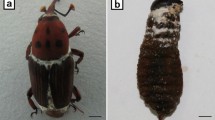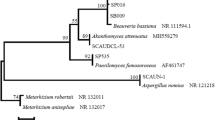Abstract
The Western flower thrips (WFT), Frankliniella occidentaliss (Pergande) (Thysanoptera: Thripidae), is the main pest of many vegetables and ornamental plants in greenhouses in Antalya province (southwestern part of Turkey). The objectives of this study were: (i) to isolate indigenous Entomopathogenic fungi (EPFs) from naturally infected individuals of WFT in the coastal area of Antalya, where greenhouse cultivation is intensively done, (ii) to identify EPF isolates using DNA sequencing, and (iii) to assess the effectiveness of the isolates against various developmental stages [larvae (1st and 2nd instars), pupa and adult (only females)] of WFT under laboratory conditions. In pathogenicity assays, all isolates were tested at three different conidial concentrations (1 × 105, 1 × 106 and 1 × 107 conidia/ml), using the spray method. Two Beauveria bassiana (Balsamo) Vuillemin (Deuteromycota: Hyphomycetes) isolates (M48 and M49) and Isaria fumosorosea Wise formerly [formerly known as Paecilomyces fumosoroseus (Wise) (Ascomycota: Hypocreales)] isolate (M50) were the most pathogenic, causing 100% mortality of WFT larvae within 7–10 days at the highest concentration (1 × 107 conidia/ml). These three isolates also caused a mortality of more than 85% in the pupae of WFT. The Lecanicillium psalliotae (Treschew) Zare & W. Gams (Ascomycota: Hypocreales) isolate (DOA3) was the most virulent against adult females of WFT, causing 100% morality at the highest concentration 10 days after treatment. The current study’s findings suggested that certain EPF extracted from WFT cadavers may provide an important foundation for the creation of bioproducts, as well as a possible alternative technique for regulating WFT.


Similar content being viewed by others
Data availability
All data generated or analyzed in this study are available in this published manuscript.
References
AKIB/MEU, (Mediterranean Exporter Unions) (2021) Export figures of 2020. Available online: http://www.akib.org.tr. Accessed December 5, 2022)
Altinok HH, Altinok MA, Koca AS (2019) Modes of action of entomopathogenic fungi. Curr Trends Nat Sci 8(16):117–124
Altschul S, Madden T, Schäffer A, Zhang J, Zhang Z, Miller W, Lipman D (1997) Gapped BLAST and PSI-BLAST: a new generation of protein database search programs. Nucleic Acids Res 25(17):3389–3402
Andersen B, Sorensen JL, Nielsen KF, van den Ende BG, de Hoog S (2009) A polyphasic approach to the taxonomy of the Alternaria infectoria species group. Fungal Genet Biol 46:642–656
Argaman Q, Klein Z, Ben Dov Y, Mendel Z (1989) Frankliniella occidentalis (Thysanoptera: Thripidae), an injurious intruder. Hassadeh 69:1268–1269
Baki D, Erler F, Tosun HS, Imrek B (2021a) Isolation and morpho-molecular identification of indigenous soil-borne entomopathogenic fungi, and their pathogenicity to Galleria mellonella L. (Lepidoptera: Pyralidae) as a model insect. Fresenius Environ Bull 30(7):8138–8148
Baki D, Tosun HS, Erler F (2021b) Indigenous entomopathogenic fungi as potential biological control agents of rose sawfly, Arge rosae L. (Hymenoptera: Argidae). Turk J Zool 45(7):517–525
Bulut E, Gocmen H (2000) Pests and their natural enemies on greenhouse vegetables in Antalya. Bull OILB/SROP 23(1):33–37
Dagli F, Tunc I (2016) Leaf residue bioassays on Frankliniella occidentalis (Pergande) (Thysanoptera: Thripidae) with different group insecticides. Mediterr Agric Sci 19(1):9–14
Davari A, Parker BL, Sullivan CF, Ghalehgolabbehbahani A, Skinner M (2021) Biological control of Western flower thrips, Frankliniella occidentalis using a self-sustaining granular fungal treatment. Bull Entomol Res 111:688–693
Doyle JJ, Doyle JL (1990) Isolation of plant DNA from fresh tissue. Focus 12:13–15
Fancelli M, Dias AB, Delalibera IJ, Cerqueira De Jesus S, Souza Do Nascimento A et al (2013) Beauveria bassiana strains for biological control of Cosmopolites sordidus (Germ) (Coleoptera: Curculionidae) in plantain. BioMed Res Int 2013(5):184756
Goettel MS, Inglis GD (1997) Fungi hyphomycetes: manual of techniques in insect pathology. Academic Press, San Diego, pp 213–248
Gouli S, Gouli V, Skinner M, Parker B, Marcelino J, Shternshis M (2008) Mortality of western flower thrips, Frankliniella occidentalis, under influence of single and mixed fungal inoculations. J Agric Technol 4(2):37–47
Gouli VV, Gouli SY, Skinner M, Shternshise MV (2009) Effect of the entomopathogenic fungi on mortality and injury level of western flower thrips, Frankliniella occidentalis. Arch Phytopathol Plant Protect 42(2):118–123
Gulzar S, Wakil W, Shapiro-Ilan DI (2021) Combined effect of entomopathogens against Thrips tabaci Lindeman (Thysanoptera: Thripidae): laboratory, greenhouse and field trials. InSects 2021(12):456. https://doi.org/10.3390/insects12050456
Hall TA (1999) BioEdit: a user-friendly biological sequence alignment editor and analysis program for windows 95/98/NT. In: Nucleic acids symposium series, vol 41. Information Retrieval Ltd., c1979–c2000, London, pp 95–98
Kimura M (1980) A simple method for estimating evolutionary rates of base substitutions through comparative studies of nucleotide sequences. J Mol Evol 16(2):111–120
Kirk DJ, Terry IL (2003) The spread of the western flower thrips Frankliniella occidentalis (Pergande). Agric For Entomol 5:301–310
Klingen I, Eilenberg J, Meadow R (2002) Effects of farming system, field margins and bait insect on the occurrence of insect pathogenic fungi in soils. Agric Ecosyst Environ 91:191–198
Lewis T (1997) Pest thrips in perspective, 1–13. In: Lewis T (ed) Thrips as crop pest. CAB International Wallingford, Oxon, p 740
Moslemi A, Ades PK, Groom T, Nicolas ME, Taylor PWJ (2017) Alternaria infectoria and Stemphylium herbarum, two new pathogens of pyrethrum (Tanacetum cinerariifolium) in Australia. Australas Plant Pathol 46:91–101
Muñiz-Reyes E, Guzmán-Franco AW, Sánc-hez-Escudero J, Nieto-Angel R (2014) Occurrence of entomopathogenic fungi in tejocote (Crataegus mexicana) orchard soils and their pathogenicity against Rhagoletis pomonella. J Appl Microbiol 117:1450–1462
Nachappa P, Challacombe J, Margolies DC, Nechols JR, Whitfield AE, Rotenberg D (2020) Tomato spotted wilt virus benefits its thrips vector by modulating metabolic and plant defense pathways in tomato. Front Plant Sci 2020(11):575564. https://doi.org/10.3389/fpls.2020.575564
Pérez-González VH, Guzmán-Franco AW, Alatorre-Rosas R, Hernández-López J, Her-nández-López A, Carillo-Benítez MG, Baverstok J (2014) Specific diversity of the entomopathogenic fungi Beauveria and Metarhizium in Mexican agricultural soils. J Invertebr Pathol 119:54–61
Sánchez-Peña SR, San-Juan LJ, Medina RF (2011) Occurrence of entomopathogenic fungi from agricultural and natural ecosystems in Saltillo, México, and their virulence towards thrips and whiteflies. J Insect Sci 11:1
Senthil-Kumar CM, Jacob TK, Devasahayam S, D’Silva S, Krishna-Kumar NK (2015) Isolation and characterization of a Lecanicillium psalliotae isolate infecting cardamom thrips (Sciothrips cardamomi) in India. Biocontrol 60:363–373
Shabana YM, Ragab ME (1997) Alternaria infectoria, a promising biological bontrol agent for the fig wax scale, Ceroplastes rusci (Homoptera: Coccidae), in Egypt. Biocontrol Sci Technol 7(4):553–564
Tamura K, Peterson D, Peterson N, Stecher G, Nei M, Kumar S (2011) MEGA5: molec-ular evolutionary genetics analysis using maxi-mum likelihood, evolutionary distance, and maximum parsimony methods. Mol Biol Evol 28:2731–2739
Thomma BPHJ (2003) Alternaria spp.: from general saprophyte to specific parasite. Mol Plant Pathol 4:225–236
Thompson JD, Higgins DG, Gibson TJ (1994) CLUSTAL W: improving the sensitivity of progressive multiple sequence alignment through sequence weighting, position-specific gap penalties and weight matrix choice. Nucleic Acids Res 22:4673–4680
Thungrabeab M, Blaeser P, Sengonca C (2006) Possibilities for biocontrol of the onion thrips Thrips tabaci Lindeman (Thys., Thripidae) using different entomopathogenic fungi from Thailand. Mitt Dtsch Ges Allg Angew Ent 15:299–304
Thungrabeab M, Tongma S (2007) Effect of entomopathogenic fungi, Beauveria bassiana (Balsam) and Metarhizium anisopliae (Metsch) on non-target insects. KMITL Sci Tech J 7(1–1):8–12
Topuz E, Erler F, Gumrukcu E (2016) Survey of indigenous entomopathogenic fungi and evaluation of their pathogenicity against the carmine spider mite, Tetranychus cinnabarinus (Boisd.), and the whitefly, Bemisia tabaci (Genn.) biotype B. Pest Manag Sci 72(12):2273–2279
TUIK (2021) Statistics on plant products. http://tuik.gov.tr/. Accessed 5 December 2022
Tunc I, Gocmen H (1994) New greenhouse pests, Polyphagotarsonemus latus and Frankliniella occidentalis in Turkey. FAO Plant Prot Bull 42:218–220
Wang Z, Xu D, Liao W, Xu Y, Zhuo Z (2023) Predicting the current and future distributions of Frankliniella occidentalis (Pergande) based on the MaxEnt species distribution model. InSects 14(5):458
Wraight SP, Ugine TA, Ramos ME, Sanderson JP (2016) Efficacy of spray applications of entomopathogenic fungi against western flower thrips infesting greenhouse impatiens under variable moisture conditions. Biol Control 97:31–47
Acknowledgements
The authors thank to the Scientific Projects Coordination Unit of Akdeniz University (Antalya, Turkey) for financially supporting the study (Project no.: BAP FDK-2019-4940).
Funding
This study was funded by the Scientific Projects Coordination Unit (SPCU) of Akdeniz University (Antalya, Turkey) under grant number BAP FDK-2019-4940.
Author information
Authors and Affiliations
Contributions
MK and FE substantially contributed to the conception and design of the article. Data curation and analysis were maintained by MK. Writing the entire manuscript was done by FE. Both authors have read, revised, and approved the manuscript.
Corresponding author
Ethics declarations
Conflict of interest
The authors declare that they have no conflict of interest.
Ethical approval
Not applicable.
Consent to participate
Not applicable.
Consent for publication
Not applicable.
Additional information
Publisher's Note
Springer Nature remains neutral with regard to jurisdictional claims in published maps and institutional affiliations.
Rights and permissions
Springer Nature or its licensor (e.g. a society or other partner) holds exclusive rights to this article under a publishing agreement with the author(s) or other rightsholder(s); author self-archiving of the accepted manuscript version of this article is solely governed by the terms of such publishing agreement and applicable law.
About this article
Cite this article
Kirisik, M., Erler, F. Isolation and molecular identification of entomopathogenic fungi from the Western flower thrips [Frankliniella occidentalis (Pergande)], and evaluation of their efficacy against the pest. J Plant Dis Prot 131, 719–730 (2024). https://doi.org/10.1007/s41348-024-00881-6
Received:
Accepted:
Published:
Issue Date:
DOI: https://doi.org/10.1007/s41348-024-00881-6




